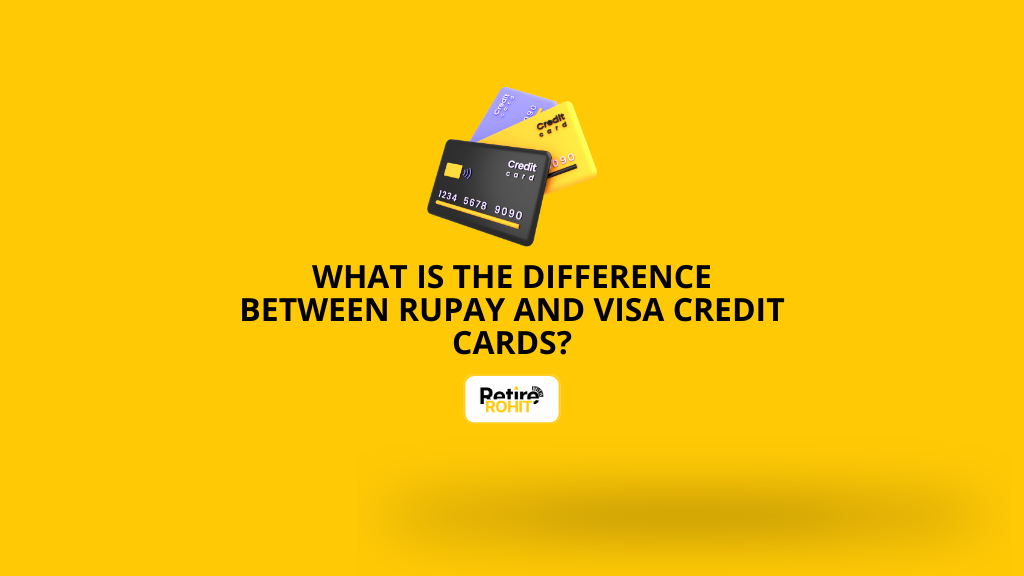What is the Difference Between Rupay and Visa Credit Cards?

If you’ve ever stood at the checkout counter wondering which card to swipe, RuPay or Visa, you’re not alone. Many people in India get confused about these two names printed on their debit or credit cards. Here we will know the difference between Rupay and Visa credit cards, as this popular payment network has unique features.
About RuPay Card
RuPay is India’s very own card network. It was launched by NPCI (National Payments Corporation of India) to reduce the country's dependence on foreign card companies. Think of RuPay as a desi UPI version of Visa, made for India’s digital future.
Key Features of RuPay Card:
- Indian Network: Issued by Indian banks, controlled in India.
- Lower Charges: Processing fees are cheaper for banks and shops.
- Aadhaar-Linked Security: Safe, fast transactions, perfect for local use.
- Government Support: Comes with schemes like PM Jan Dhan Yojana (PMJDY).
- Focused on India: Best for domestic shopping, bill payments, travel, and more.
RuPay is not just a card; it’s part of India’s push for self-reliance in digital payments.
About Visa Credit Card
Visa is a US-based global payment network used in over 200 countries. It's like an international passport for your money, whether you’re booking a hotel in Goa or shopping on Amazon USA. Most Indian private banks like HDFC, ICICI, and Axis issue Visa cards because of their global acceptance and premium features.
Key Features of Visa Credit Card:
- Accepted Worldwide: Use it in India, Dubai, the US, anywhere.
- High Security: Comes with global fraud protection and chip security.
- Perfect for Travellers: Great for international bookings, forex payments, etc.
- Premium Perks: Airport lounge access, global brand discounts, and cashback deals.
Visa is your go-to card when you need global access, premium services, and travel benefits.
Fees and Charges: RuPay vs Visa
Every time you swipe your card, a small fee is deducted, either from you, the merchant, or the bank. Here’s how RuPay and Visa compare when it comes to these charges:
- RuPay is cheaper for Indian users because it processes payments within India.
- Visa costs more, especially when used for international shopping or travel, because of foreign exchange fees and international routing.
| Fee Type | RuPay | Visa |
| Domestic Fee | Low or Zero | Moderate |
| International Fee | Not Supported (Limited) | 1%–3% per transaction |
| Currency Conversion | Not Applicable | Charges apply for foreign use |
Use RuPay for local spending to save on fees. Use a Visa only when shopping or traveling abroad.
Difference Between Rupay and Visa Credit Card
Here are the differences between Rupay and Visa Credit cards:
| Feature | Rupay | Visa Credit Card |
| Launched By | This card is launched by the National Payments Corporation of India (NPCI) | This card is launched by Visa Inc. |
| Origin | India | USA |
| Currency Conversion | They have Limited support | They have full support for international currencies |
| Global Acceptance | They have a Limited (mainly in India, slowly expanding abroad) | They have been widely accepted worldwide |
| Transaction Charges | They charge Lower (domestic) | They charge Higher, especially for international transactions |
| Card Issuers | By Indian banks | By Indian and international banks |
| Processing Time | This is Faster for domestic transactions | This is slightly longer due to international routing |
Conclusion
In conclusion, RuPay is Indian, simple, and great for local use, and Visa is global, premium, and good for international use. If you only spend in India, go with RuPay, and if you travel, shop online internationally, or want more features, go with Visa. Or better, keep both. One for India, one for the world. We hope our blog What is the Difference between Rupay and Visa Credit card is helpful.


